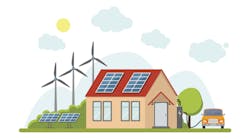Stagnant Electricity Demand Growth in the Short Term Expected to Turn Around Beyond 2025
Ninety-five percent of utilities executives agree that the risk of electricity consumers going largely off the grid and only using it as occasional backup will increase significantly in the next two years, according to a study from Accenture, conducted as part of the company’s Digitally Enabled Grid research program.
The deployment of distributed generation (DG) technologies like rooftop solar is increasing faster than utilities can build new grid capacity to handle it in high-demand areas, according to the vast majority (95%) of the 150 executives surveyed across 25 countries. In fact, almost half (48%) of the respondents said that parts of their grid will reach maximum capacity in three years or less, with only 1% believing it will take longer than five years.
The proportion of both residential and commercial consumers with rooftop solar photovoltaics in the markets modeled could even exceed 15% by 2036 in some markets, such as California. This trend will likely continue to affect net electricity demand growth for the foreseeable future.
The study also notes that increased deployment of DG will complicate utilities’ operations, requiring distribution utilities to act now to avoid the excessive grid-reinforcement spending required to host new DG energy flows.
According to Accenture modeling, some markets could generate substantial capital reinforcement cost savings simply through better identification of local constraints on the distribution network. A 10% improved accuracy in DG forecasts, resulted in projected savings of 15-28% in New York, 14-18% in California, 14-15% in Australia, and 11-12% in both the United Kingdom and the Netherlands.
In fact, DG integration was ranked as the second-highest priority area as a cost-saving opportunity, selected by 59% of respondents as one of their top five choices. The top priority, chosen by 61% of respondents, was reducing supply chain unit costs through improved forecasting of materials and service requirements.
“Distribution businesses have had a tough time in recent years with weak demand, which is one reason why grid operators’ profits have been squeezed,” said Stephanie Jamison, a managing director at Accenture who leads its Transmission and Distribution business. “The proliferation of DG changes electricity demand profiles, potentially diminishing total demand without necessarily reducing peak demand. Successful DG integration will require substantial investments in new connections and grid reinforcement to modernize the network and sustain the same level of reliability and safety and secure operations.”
While DG presents a challenge to distribution utilities, it’s also an opportunity, with 95% of respondents saying that DG and storage-services provision will be a major profit growth area for distribution companies beyond 2025. More than half of respondents globally also identified owning each of the following assets as an opportunity for their business going forward: large-scale DG; grid-connected storage; small-scale prosumer DG; and community storage.
Electrification of transport and buildings will bolster electricity demand growth after 2026
Accenture modeling predicts that, following a period of stagnation, electricity demand could grow by 31% between 2026 and 2036. The study and modeling partly attribute the growth to the meaningful impact that electric vehicles (EVs) and building heating electrification will have on demand growth starting around 2025.
The modeling revealed that the total percentage of plug-in electric vehicles in the overall vehicle stock is forecast to grow relatively slowly, from 1% this year to 3% by 2025, but could rise to 37% by 2040, led by municipal buses, scooters and small commercial vehicles.
This trend could translate to substantial new electricity demand. Indeed, while the electricity consumption of EVs is expected to represent just over 1% of the annual peak demand hour by 2025, it is forecast to rise almost fourfold in the markets modeled by 2040, to 4%. In some markets like France and California, forecasts are even higher by that year (10% and 8%, respectively).
The decarbonization of buildings is also likely to push up electricity demand in the long term, with 96% of utilities executives agreeing that decarbonization efforts will substantially reduce residential and commercial natural gas demand by 2040.
Just the combined effects of transport and heating electrification could push peak demand up significantly, with Accenture modeling suggesting that the average electricity consumption during the peak demand hour could rise by around 63 percent from 2016 in 2040.
“Mass adoption of electric vehicles and the electrification of building heating is poised to alter demand growth and load shape in the longer term,” Jamison said. “This suggests high growth potential for utility distributors, but it will also put pressure on grid stability. The key will be to navigate this disruption by making the grid more resilient through greater use of smart technologies and utilizing all sources of flexibility including on the demand side, adopting a more customer-centric approach.”



